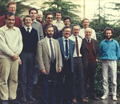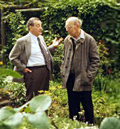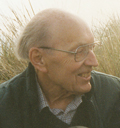
|
|
|
Dick's life with physics, page 8 |
|
|
|
|
|
1982 was the centenary of the birth of Max Born, and the IOP Optical Group decided that its September conference that year should be held in Edinburgh in Born's honour. Some of the new graduates who had followed the Modern Optics option were more than willing to be pressed into service as ushers. Emil Wolf was the guest speaker, visiting Edinburgh for the first time in 28 years to give an account of his time with Born. The character of the university had changed. "Academia is no longer the life for a gentleman" Bill Cochran was to say when he retired in 1988, prompting solid state theorist Alastair Bruce to comment wryly "and no longer the place for a scholar". Physics now had a Head of Department democratically elected by the academic staff, and there was great pressure from the University administration to establish close links with industry and to secure large scale grants from the Research Councils. In 1982 Roger Cowley, as HoD, encouraged all staff to concentrate their research efforts within larger groups so that the Department could bid more effectively for external funding. In response seven academic staff (Dick, now a Reader, George Bradford, Dick Dougal, Norman Fancey, Stuart McKirdy, Alastair Rae and David Vass) came together bringing expertise in optics, electronics, microcomputers, computational physics, photon detection and management to explore possibilities for image processing and pattern recognition in real time using coherent optical processors. The following session David Wallace (who had been an undergraduate in the late 1960s and was now Tait Professor) was elected as the new HoD. He was very supportive when Dick suggested setting up an Applied Optics Group involving about 20% of the academic staff in the Department. Under Dick's leadership, academics, research staff and postgraduate students cooperated enthusiastically to develop an idea from David Vass - liquid crystal over a silicon chip for use as a spatial light modulator in coherent optical data processing. The first chip with 16x16 pixels was made between 1984 and 1985, and this involved close collaboration with the Department of Electrical Engineering, a collaboration which has lasted for over two decades. Since the demands of the design exceeded the then computing capacity at the University, access was gained to national computing facilities at the Rutherford Appleton Laboratory at Harwell. (One year the Group's requirements exceeded the whole budget allocated for micro-fabrication at RAL but SERC provided additional funds.) Strong links were forged with industrialists at STC Harlow, GEC Marconi Chelmsford and later CRL Hayes, as well as with groups doing similar work at UMIST, Manchester, and Boulder, Colorado. During this exciting period in the 80s more than a dozen talented research students and research workers joined the Group. Winifred helped several of them develop a better understanding of the diffraction of light at the regular arrays of pixels in the SLMs. Some continued their careers in the rapidly developing field of optoelectronics - Ian Underwood became a lecturer and later professor in Electrical Engineering, spinning out a very successful company, Micro-Emissive Displays (MED); Douglas McKnight joined Heriot Watt and later Boulder Displays; Mike Snook after many years service joined MicroPix, a company set up by the Group's industrial collaborators to exploit the liquid crystal-over-silicon technology; Alastair MacGregor joined a consultancy company in Cambridge; and Steven Heddle worked on image processing in the Royal Observatory on Blackford Hill for a few years before returning to his native Orkney. Will Hossack, a former undergraduate at Edinburgh, came back to join the Group as a lecturer in 1990. A DTI/SERC grant enabled successful production of a 176x176 pixel SLM in 1990, involving GEC, STL, UMIST and Edinburgh. This was Dick's last major grant before his retirement, and it was hailed by the external assessors as a flagship project of the UK JOERS programme to promote new optoelectronics technologies. A very different industrial connection was made in 1986 when Strand Lighting asked for help with their flood/spot theatre luminaires. Dick undertook a redesign in co-operation with Strand staff in Kirkcaldy, and was able to make considerable improvements. On another occasion, he was asked to meet representatives from a firm in the north of Scotland which was having difficulties with its devices for undersea visual monitoring. Dick identified the problem there and then, and outlined how it could be overcome. University-industry liaison was not pleased when the firm decided that, with what Dick had told them, they could now solve the problem themselves. In 1988 Reading's Optics department invited Dick to be external assessor for their MSc course. This gave particular pleasure to one of his long-standing admirers - Brian Blandford, who had taken the quantum mechanics course in 1963-4 as a mathematics student in the Arts faculty. Brian went on to Reading to do a PhD with Harold Hopkins, and became one of the country's leading lens designers. Between 1987 and 1990 Dick was Meetings Secretary of the Royal Society of Edinburgh, an enjoyable duty which involved writing detailed minutes of lectures on a wide variety of topics. In June 1990 Emil, visiting for the third time since 1954, was awarded an honorary degree by the University of Edinburgh. In September 1990 Dick was declared Reader Emeritus, at a reception in the Upper Library to mark his retirement 50 years after he had first come to Edinburgh as a student. At the end of October he was in Glasgow to give a talk to the Glasgow Royal Philosophical Society. The Society's President was Leslie Barr, professor of physics at Paisley College where Dick had been external examiner from 1977 to 1980. Leslie had specially requested that the talk should be about the Maskelyne experiment. Like Alastair Rae, Leslie had been one of the second cohort whom Dick had taught to play croquet at The Burn. Following the meeting and a luxurious night in one of Glasgow's best hotels, Dick and Winifred set off through the Trossachs in the first snow of winter on the first day of November, with a sense of freedom at last. |

 


|
| Site index |